
(Download a higher resolution picture by clicking on any
picture below. 
The third X-43A Hyper-X mission was scheduled for Monday, November 15. Take-off was scheduled for 1:00 P.M. and launch of the Hyper-X stack was scheduled for 2:00 P.M.
I hit the road at 7:30 in the morning to give myself plenty of time to get to the NASA Dryden Flight Research Center, 160 miles from Goleta. There was quite a crowd lined up to get day passes in the guard shack at the base gate.
Shortly after noon, the media photographers put their gear in the NASA vans and piled in for the ride around to south base. We were driven past the 747 Airborne Laser ground test facility on the south side of the main runway. The nose of a 747 fuselage poked out of the side of one of the buildings. There were Boeing B-52H Stratofortresses and Rockwell B-1B Lancers parked near the ABL facility. There was also a large collection of Ryan RQ-4A Global Hawks. We were treated to a brief tour of the Air Force Flight Test Center annex on the old South Base ramp.
We were driven to a position about 1,000 feet from the south side of the main runway near the 11,000 foot marker. The NASA public affairs officer gave us our choice of shooting from the same small knoll that we had used for the mission in March or a lower spot on an old dirt road a little farther down the runway.
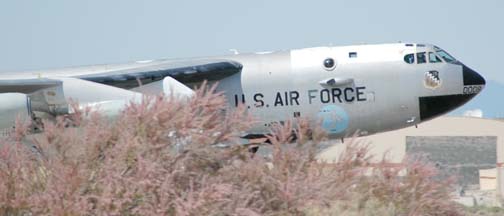 Remembering this picture that I took of the
March 27 Hyper-X mission, I decided to set up on the road, so the NB-52B should be higher
off the ground as it went by.
Remembering this picture that I took of the
March 27 Hyper-X mission, I decided to set up on the road, so the NB-52B should be higher
off the ground as it went by.
Most of the photographers set up their gear in a row across the dirt road. The NASA PAO instructed us not to go into the bushes due the the threat of Mojave Green Rattlesnakes. It was quite a collection of long Canon and Nikon telephoto lenses. We made sure to ask the Air Force Public Affairs Officer for permission before we photographed any Air Force airplanes.
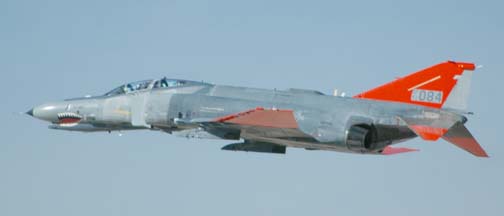 A few minutes before 1:00 we were treated to a low pass
along Runway 22 by McDonnell-Douglas QF-4E Phantom II drone, 71-1084 from the Mojave Airport.
Its McDonnell-Douglas construction number is 4256. It was retired to AMARC as
FP0681 on May 31, 1991.
A few minutes before 1:00 we were treated to a low pass
along Runway 22 by McDonnell-Douglas QF-4E Phantom II drone, 71-1084 from the Mojave Airport.
Its McDonnell-Douglas construction number is 4256. It was retired to AMARC as
FP0681 on May 31, 1991.
 Northrop T-38A Talon, 64-13302 of the 412th Test Wing.
Northrop T-38A Talon, 64-13302 of the 412th Test Wing.
 General Dynamics F-16B Block 15P Fighting Falcon, 82-1047 of the 412th Test Wing.
General Dynamics F-16B Block 15P Fighting Falcon, 82-1047 of the 412th Test Wing.
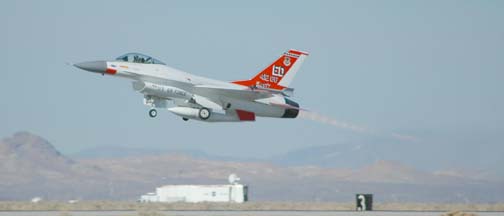 General Dynamics F-16A Block 15AR OCU Fighting Falcon, 92-0407 of the 412th Operations Group.
This F-16 was intended for delivery to Pakistan, but its export was prevented by an embargo.
It was on static display at the Vandenberg AFB airshow on October 31.
General Dynamics F-16A Block 15AR OCU Fighting Falcon, 92-0407 of the 412th Operations Group.
This F-16 was intended for delivery to Pakistan, but its export was prevented by an embargo.
It was on static display at the Vandenberg AFB airshow on October 31.
We got the word that a GPS or Inertial Navigation System failure had postponed the launch. The technicians rebooted the system twice trying to get everything running properly for the mission. Each reboot chewed up forty minutes of precious time.
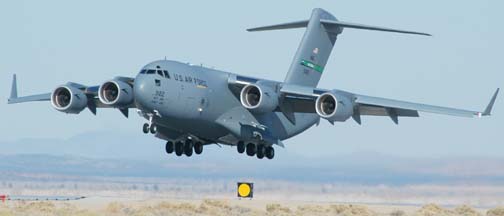 Boeing C-17A Lot XV Globemaster III, 03-3122 of the 62nd AW and 446th AW
based at McChord Air Force Base.
Boeing C-17A Lot XV Globemaster III, 03-3122 of the 62nd AW and 446th AW
based at McChord Air Force Base.
 Boeing C-17A Lot XV Globemaster III, 03-3122 scrubs smoke from
its tires as it touches down on Runway 22.
Boeing C-17A Lot XV Globemaster III, 03-3122 scrubs smoke from
its tires as it touches down on Runway 22.
The technicians called for the NB-52B to start its engines and pulled the umbilicals from the Pegasus booster and the X-43A.
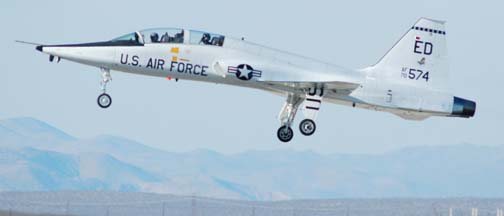 The sun was getting low in the sky when
Northrop T-38A-85-NO Talon, 70-1574 of the 412th Test Wing made a touch-and-go
landing at a quarter to three.
The sun was getting low in the sky when
Northrop T-38A-85-NO Talon, 70-1574 of the 412th Test Wing made a touch-and-go
landing at a quarter to three.
The flight crew got the engines started on the NB-52B and powered up the stack, but the block of time available for the mission to use the Pacific test range only ran from 2:00 to 4:00. They couldn't get to the launch point in time to splash down before the close of the launch window.
The technicians shut down the systems of the stack and began to prepare for another launch attempt on Tuesday.
I was told that two Lockheed P-2 Neptune aerial tankers are currently based at Fox Field, west of Lancaster. They are fully instrumented to evaluate their suitability for the resumption of air tanker operations. I stopped by Fox Field on my way back to Goleta. It was nearly sunset, and a cloud bank obscured the setting sun.
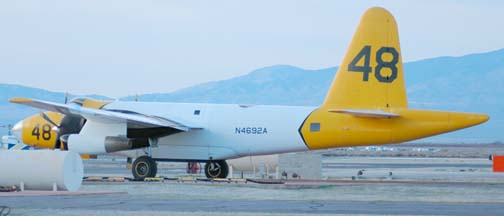 Lockheed SP-2H Neptune, N4692A Tanker #48
was built in 1961.
Lockheed SP-2H Neptune, N4692A Tanker #48
was built in 1961.
 Lockheed P2V-5 Neptune, N1386C Tanker #44 was built
for the U. S. Navy as BuNo 128422
in 1951. It is operated by Neptune Aviation Services of Missoula, Montana.
Lockheed P2V-5 Neptune, N1386C Tanker #44 was built
for the U. S. Navy as BuNo 128422
in 1951. It is operated by Neptune Aviation Services of Missoula, Montana.
 Boeing KC-97G Stratotanker 53-0272
of the California Air Guard is part of the collection of the Milestones of Flight Museum.
It is reported that this Stratotanker is being
restored to airworthy condition for ferrying to another museum. Can
anyone tell me when it is expected to fly or where it is going?
Boeing KC-97G Stratotanker 53-0272
of the California Air Guard is part of the collection of the Milestones of Flight Museum.
It is reported that this Stratotanker is being
restored to airworthy condition for ferrying to another museum. Can
anyone tell me when it is expected to fly or where it is going?
Updated December 5, 2005: The KC-97G is not being restored to airworthy condition and it is unlikely that it will fly again.
Tuesday started a lot like Monday. I got an early start to make time for a stop by the Fox Field tanker station.
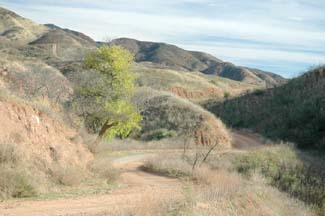 My route from Goleta to Edwards air Force
Base includes this stretch of badly rutted dirt road that runs through the Angeles Forest.
My route from Goleta to Edwards air Force
Base includes this stretch of badly rutted dirt road that runs through the Angeles Forest.
I went back to Fox Field to shoot more pictures of the tankers in daylight.
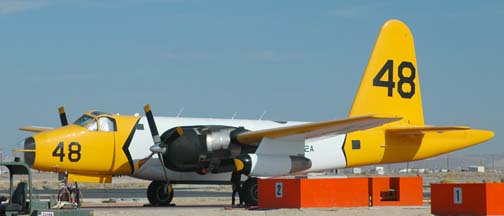 Lockheed SP-2H Neptune, N4692A Tanker #48.
Lockheed SP-2H Neptune, N4692A Tanker #48.
 Boeing KC-97G Stratotanker 53-0272.
Boeing KC-97G Stratotanker 53-0272.
 Armstrong Whitworth Argosy, N1430Z and
wingless, executive conversion of North
American B-25C Mitchell, N3968C. The Argosy belongs
to the Santa Monica Museum of Flying.
Its Armstrong Whitworth construction number is 6779.
Armstrong Whitworth Argosy, N1430Z and
wingless, executive conversion of North
American B-25C Mitchell, N3968C. The Argosy belongs
to the Santa Monica Museum of Flying.
Its Armstrong Whitworth construction number is 6779.
 North
American B-25C Mitchell, N3968C belongs to
the Milestones of Flight Museum. Its Army Air Corps serial number was 41-13251 and
its North American construction number is 82-5886.
North
American B-25C Mitchell, N3968C belongs to
the Milestones of Flight Museum. Its Army Air Corps serial number was 41-13251 and
its North American construction number is 82-5886.
Link to the Warbirds Resource Group page about B-25C, N3968C.
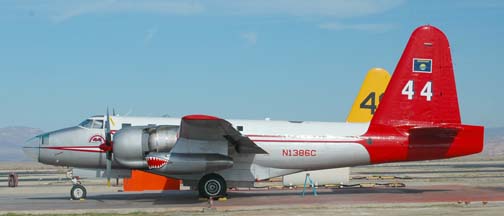 Lockheed P2V-5 Neptune, N1386C Tanker #44
Lockheed P2V-5 Neptune, N1386C Tanker #44
 The tails of Lockheed P2V-5 Neptune, N1386C
Tanker #44 and SP-2H Neptune, N4692A Tanker #48.
The tails of Lockheed P2V-5 Neptune, N1386C
Tanker #44 and SP-2H Neptune, N4692A Tanker #48.
There were no visitors in the guard shack at the base gate. I had a new day pass in no time and was on my way to NASA Dryden with an hour to spare. I used the spare time to photograph their display airplanes.
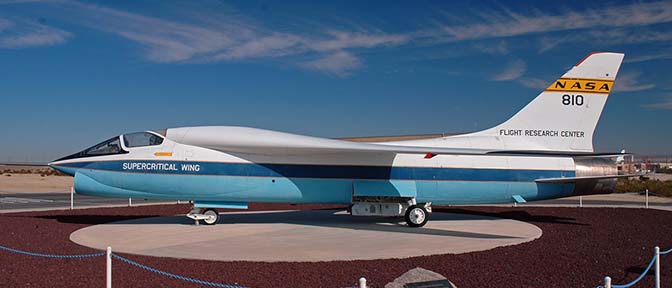 Vought F-8 Supercritical Wing, N810NA.
Vought F-8 Supercritical Wing, N810NA.
Link to the NASA Dryden Fact Sheet for the F-8 Supercritical Wing.
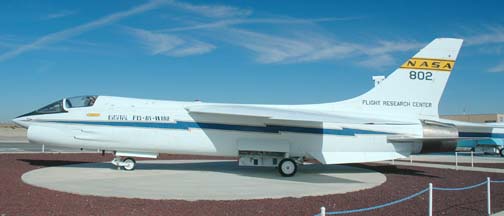 Vought F-8 Digital Fly By Wire, N802NA
Vought F-8 Digital Fly By Wire, N802NA
Link to the NASA Dryden Fact Sheet for the F-8 Digital Fly By Wire.
 Grumman X-29 Forward Swept Wing demonstrator, 049.
Grumman X-29 Forward Swept Wing demonstrator, 049.
Link to the NASA Dryden Fact Sheet for the X-29 Forward Swept Wing.
 Lockheed F-104G Starfighter, N826NA was the
last operational Starfighter in the United States.
Lockheed F-104G Starfighter, N826NA was the
last operational Starfighter in the United States.
Link to the NASA Dryden Fact Sheet for the Lockheed F-104G Starfighter, N826NA.
We arrived at the runway shortly after noon. The weather at Edwards Air Force Base was perfect for the third flight of the X-43A Hyper-X. There was almost no wind and the air temperature was in the sixties.
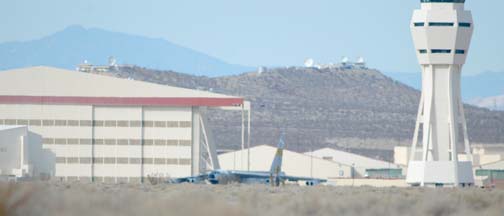 NASA's
Boeing NB-52B Stratofortress mothership taxied out with the X-43A Stack at half past noon.
NASA's
Boeing NB-52B Stratofortress mothership taxied out with the X-43A Stack at half past noon.
A number of the airplanes assigned to Edwards Air Force Base took off and landed while we waited for the NB-52B to take off. Once again the photographers made sure to get permission from the Air Force Public Relations Officer before photographing the Air Force jets.
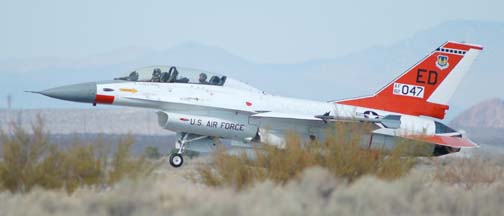 General Dynamics F-16B Block 15P Fighting
Falcon, 82-1047 of the 412th Test Wing.
General Dynamics F-16B Block 15P Fighting
Falcon, 82-1047 of the 412th Test Wing.
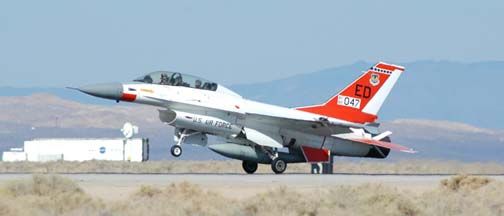 General Dynamics F-16B Block 15P Fighting
Falcon, 82-1047.
General Dynamics F-16B Block 15P Fighting
Falcon, 82-1047.
 Northrop T-38A Talon, 64-13302 of
the 412th Test Wing.
Northrop T-38A Talon, 64-13302 of
the 412th Test Wing.
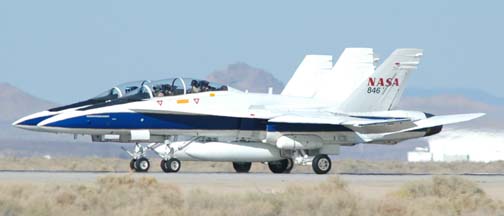 NASA McDonnell-Douglas F/A-18B Hornet chase planes
N846NA and N852NA took-off from Runway 22 at 1:00 P.M., few minutes before the NB-52B carrying the
X-43A began its take-off roll.
NASA McDonnell-Douglas F/A-18B Hornet chase planes
N846NA and N852NA took-off from Runway 22 at 1:00 P.M., few minutes before the NB-52B carrying the
X-43A began its take-off roll.
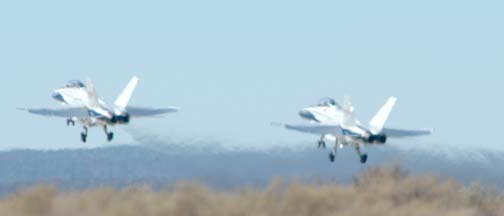 The Hornets were piloted by Dana Purifoy and Dick Ewers.
In the back seats of the Hornets, Jim Ross shot video and Carla Thomas shot still photographs.
The Hornets were piloted by Dana Purifoy and Dick Ewers.
In the back seats of the Hornets, Jim Ross shot video and Carla Thomas shot still photographs.
 The Hornets turned around and approached from the west. The first
indication that the NB-52B had begun rolling was a dense cloud of sooty smoke on the
horizon. That group of photographers chose to photograph the take-off from the knoll
we had occupied for the March flight.
The Hornets turned around and approached from the west. The first
indication that the NB-52B had begun rolling was a dense cloud of sooty smoke on the
horizon. That group of photographers chose to photograph the take-off from the knoll
we had occupied for the March flight.
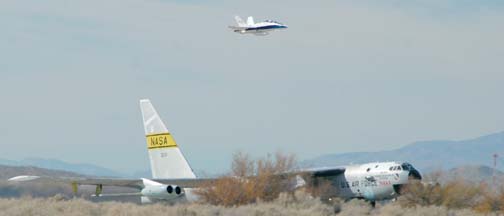 The F/A-18Bs caught up with the NB-52B just as it
rotated. That same damn bush that got in my picture in March jumped into this picture, too.
The F/A-18Bs caught up with the NB-52B just as it
rotated. That same damn bush that got in my picture in March jumped into this picture, too.
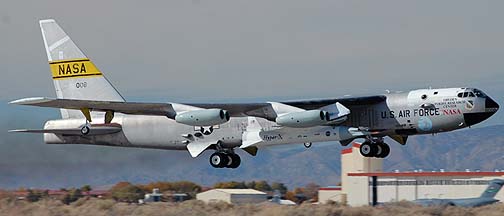 The NB-52B Stratofortress mothership lifted the
X-43A from Runway 04 shortly after 1:00 P.M. It was piloted by former Space Shuttle pilot
C. Gordon Fullerton. The co-pilot was Frank Batteas, who had flown one of the F/A-18B chase
planes on the Mach-7 mission last March. Orbital Sciences employee Brian Minnick
manned the launch panel and NASA Dryden's Brad Neal monitored the
X-43A systems aboard the NB-52B.
The NB-52B Stratofortress mothership lifted the
X-43A from Runway 04 shortly after 1:00 P.M. It was piloted by former Space Shuttle pilot
C. Gordon Fullerton. The co-pilot was Frank Batteas, who had flown one of the F/A-18B chase
planes on the Mach-7 mission last March. Orbital Sciences employee Brian Minnick
manned the launch panel and NASA Dryden's Brad Neal monitored the
X-43A systems aboard the NB-52B.
You can buy framed prints or greeting cards of this photograph.
Link to the NASA Dryden biography for C. Gordon Fullerton.
Link to the NASA Dryden biography for Frank Batteas.
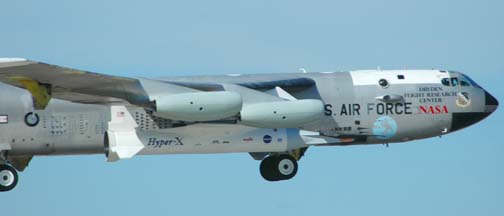 The X-43A was propelled to its operating speed and
altitude by a modified Orbital Sciences Pegasus booster.
The X-43A was propelled to its operating speed and
altitude by a modified Orbital Sciences Pegasus booster.
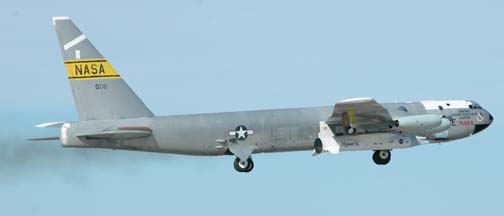 The main landing gear trucks of the NB-52B rotated
as they retracted
into the fuselage. Castle Butte, familiar to viewers of X-15 landing films, is visible in the
background of the larger version of the photo.
The main landing gear trucks of the NB-52B rotated
as they retracted
into the fuselage. Castle Butte, familiar to viewers of X-15 landing films, is visible in the
background of the larger version of the photo.
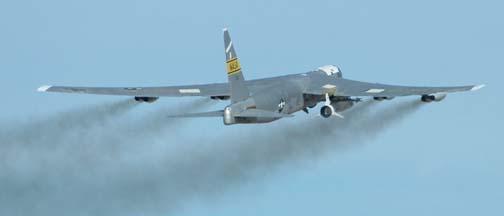 Pilot C. Gordon Fullerton made a hot take-off, pulling the
NB-52B mothership into a steep climb after lift-off.
Pilot C. Gordon Fullerton made a hot take-off, pulling the
NB-52B mothership into a steep climb after lift-off.
 After climbing a few thousand feet, the NB-52B pitched over into
a shallower climb.
After climbing a few thousand feet, the NB-52B pitched over into
a shallower climb.
We returned to NASA Dryden immediately following the take-off. We watched the live transmission from the chase plane on monitors in the press room.
It took a little more than an hour for the NB-52B to get into position for launch, over the Pacific Ocean about 110 miles southwest of Santa Barbara. The NB-52B launched the Hyper-X stack at an altitude of 40,000 feet, heading due west. The stack dropped for five seconds before the Pegasus booster ignited.
The Pegasus booster climbed to 110,000 feet and accelerated to Mach 9.8 in about 90 seconds and then released the X-43A. Once it was established that the X-43A was in stable flight, the engine cowl doors opened. Hydrogen fuel was injected into the combustion chamber and ignited with Silane. Cumbustion was maintained in the airflow going faster than the speed of sound through the engine. The thrust of the engine was approximately equal to the drag of the vehicle, simulating cruise flight, for ten seconds. The X-43A flew twenty miles in those ten seconds.
After the successful conclusion of the mission, we went outside to await the return of the NB-52B.
 I snapped this picture of the Northrop HL-10 lifting body on its pylon at the
entrance to Dryden as I checked the manual exposure setting of my camera.
I snapped this picture of the Northrop HL-10 lifting body on its pylon at the
entrance to Dryden as I checked the manual exposure setting of my camera.
Link to the NASA Dryden Fact Sheet for the HL-10 lifting body.
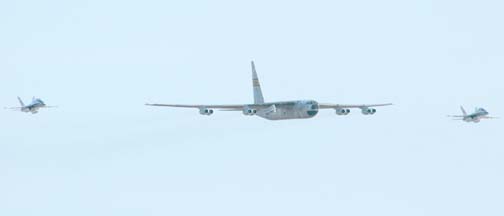 NASA's
Boeing NB-52B Stratofortress mothership was flanked by the two white and blue Hornet chase
planes as it approached the NASA Dryden Flight research Center after the flight of the X-43A.
NASA's
Boeing NB-52B Stratofortress mothership was flanked by the two white and blue Hornet chase
planes as it approached the NASA Dryden Flight research Center after the flight of the X-43A.
 It was the last mission of the
NB-52B mothership, which first
carried the North American X-15 #1 on December 16, 1959. Its first X-15 launch was the first flight of the
X-15 #1 on Janary 23, 1960.
It was the last mission of the
NB-52B mothership, which first
carried the North American X-15 #1 on December 16, 1959. Its first X-15 launch was the first flight of the
X-15 #1 on Janary 23, 1960.
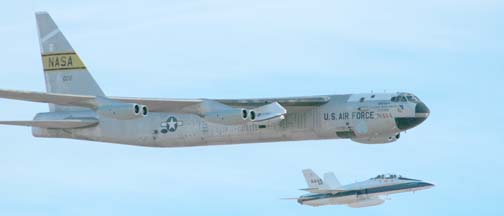 The side of the fuselage of the NB-52B mothership is
dotted with silhouettes representing the many different vehicles and test devices that
it has carried in its forty-five year long career.
The side of the fuselage of the NB-52B mothership is
dotted with silhouettes representing the many different vehicles and test devices that
it has carried in its forty-five year long career.
 Somebody got the stupid idea to tag the
NB-52B with a plug for NASA Dryden on the side of the nose for the last mission. Now the
NB-52B will be preserved with markings that it wore on only one mission.
Aside from the addition of the little mission symbols, its markings haven't been altered in 28 years.
As an aviation history preservationist, I see it being akin to vandals attacking the
plane with spray paint cans.
Somebody got the stupid idea to tag the
NB-52B with a plug for NASA Dryden on the side of the nose for the last mission. Now the
NB-52B will be preserved with markings that it wore on only one mission.
Aside from the addition of the little mission symbols, its markings haven't been altered in 28 years.
As an aviation history preservationist, I see it being akin to vandals attacking the
plane with spray paint cans.
 The NB-52B flew past the rocket test stands on
Lehmann Ridge at the conclusion of its last launch mission.
The NB-52B flew past the rocket test stands on
Lehmann Ridge at the conclusion of its last launch mission.
 The NB-52B flew over Rogers Lake (which actually
has a few inches of water in it right now) as it approached Runway 22 to make a touch-and-go
landing and one more circuit in the pattern.
The NB-52B flew over Rogers Lake (which actually
has a few inches of water in it right now) as it approached Runway 22 to make a touch-and-go
landing and one more circuit in the pattern.
It has been reported that the NB-52B may make one final farewell flight in early 2005. I would suggest the date of January 23, 2005 for its final flight. That is the forty-fifth anniversary of its first X-15 launch.
Shortly after 4:00 P.M. Dryden hosted a press briefing about the successful Mach-10 mission. When the briefing concluded at 5:00 the sun had set. The horizon was lit up like a bright yellow fire.
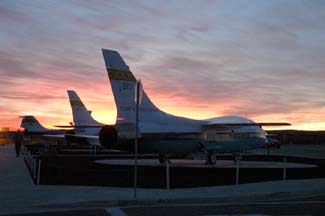 The brilliantly colored sky made a dramatic
backdrop for the airplanes displayed at NASA Dryden.
The brilliantly colored sky made a dramatic
backdrop for the airplanes displayed at NASA Dryden.
 The crescent Moon hung in the sky above the
replica of X-15 #3.
The crescent Moon hung in the sky above the
replica of X-15 #3.
Link to the NASA Dryden Fact Sheet for the Lockheed SR-71 Blackbird.
 Boeing NB-52B
Stratofortress Mothership.
Boeing NB-52B
Stratofortress Mothership.
It has been asserted that the Boeing NB-52B Stratofortress, carrying Air Force serial 52-0008, can lay claim to being the airplane that has seen and participated in more history than any other single airplane. For forty-five years, the NB-52B was a fixture at Edwards Air Force Base. While the NB-52B is most famous for launching the three North American X-15 rocket planes, it continued to serve in the role of launch platform for a multitude of programs until its final mission on November 16, 2004. It was the oldest flying B-52 by nearly ten years.The NB-52B launched the three X-15 hypersonic rocket planes.
It launched the Northrop HL-10, Northrop M2-F2/F3, Martin Marietta X-24A and Martin Marietta X-24B lifting bodies.
It simulated the steep, power off approach to landing used by the Space Shuttles.
It assisted in the collection of data about wake turbulence from large aircraft.
It served as an air-to-air gunnery target.
It launched 3/8-scale F-15 Remotely Piloted Research Vehicles (RPRV) and Spin Research Vehicles (SRV).
It launched a Ryan Firebee II drone and the Ryan Firebee based Drones for Aeroelastic Structures Testing (DAST).
It launched the Highly Maneuverable Aircraft Technology (HiMAT) RPRVs.
It dropped the 48,000-pound Space Shuttle Reusable Booster Drop Test Vehicle (SRB/DTV).
It released a simulated F-111 crew module from its bomb bay to evaluate new parachute recovery systems.
It was the first airplane to launch a satellite into orbit on the Orbital Sciences Pegasus booster.
It tested the drag chute used to decelerate space shuttle orbiters.
It tested pollution reducing fuel additives with a pair of jet engines mounted under its bomb bay.
It launched the X-38 Space Station Crew Return Vehicles.
It launched the X-43A Hyper-X Supersonic Combustion Ramjets.
The book is 200 pages long. It contains 246 color photographs, 89 black and white photographs, and 2 other illustrations.
You can preview the first several pages of the book.
Books are printed on demand by Lulu.com. When you order one, it is placed in your Lulu.com shopping cart. Lulu.com prints, packages, and ships the book direct to you.

Put a copy of the softcover edition of Balls Eight: History of the Boeing NB-52B Stratofortress Mothership in your Lulu.com shopping cart for $74.95.

Put a copy of the hardcover edition of Balls Eight: History of the Boeing NB-52B Stratofortress Mothership in your Lulu.com shopping cart for $79.95.
eBook edition of Balls Eight: History of the Boeing NB-52B Stratofortress Mothership |
||
|
My book Balls Eight: History of the Boeing NB-52B Stratofortress Mothership is now available as an eBook for just $10.99, a considerably reduced price compared to the print edition. It has been asserted that the Boeing NB-52B Stratofortress, carrying Air Force serial 52-0008, can lay claim to being the airplane that has seen and participated in more history than any other single airplane. For forty-five years, the NB-52B was a fixture at Edwards Air Force Base. While the NB-52B is most famous for launching the three North American X-15 rocket planes, it continued to serve in the role of launch platform for a multitude of programs until its final mission, launching the Mach-10 X-43A Hyper-X, on November 16, 2004. It was the oldest flying B-52 by nearly ten years. The eBook edition is profusely illustrated with vintage photographs and diagrams and has more pictures than the print edition. It can be dowloaded directly from Lulu.com. It will soon be available from Apple iBookstore, Amazon, Barnes & Noble, and Kobo. | ||
|
Balls Eight: History of the Boeing NB-52B Stratofortress Mothership |
||
Revell has re-released Monogram's 1/72-scale Boeing NB-52B Stratofortress with X-15A-2 kit. You need this book to help you establish the appropriate paint scheme for any particular NB-52B mission that you want to model.
The book is 96 pages long.
You can preview the first several pages of the book.
Books are printed on demand by Lulu.com. When you order one, it is placed in your Lulu.com shopping cart. Lulu.com prints, packages, and ships the book direct to you.
 Put a copy of the softcover edition of Painting Guide for the Boeing Stratofortress Motherships in your Lulu.com shopping cart for $44.95.
Put a copy of the softcover edition of Painting Guide for the Boeing Stratofortress Motherships in your Lulu.com shopping cart for $44.95.
You can buy a 2020 calendar featuring photographs of the Boeing NB-52B Stratofortress Mothership that launched the X-15s in the 1960s and continued launching research vehicles until 2004.
It has been asserted that the Boeing NB-52B Stratofortress, carrying Air Force serial 52-0008, can lay claim to being the airplane that has seen and participated in more history than any other single airplane. This calendar features a dozen pictures of the NB-52B carrying some of the research vehicles that it launched over the years. Photo sources: Air Force, NASA, Richard Lockett, Brian Lockett:
North American X-15-1, 1960
North American X-15-3, 1963
North American X-15A-2, 1967
Northrop HL-10, 1969
Martin-Mariettta X-24A, 1970
Northrop M2-F3, 1972
Martin-Mariettta X-24B, 1973
Orbital Sciences Pegasus, 1989
Supersonic Supercruise, 1995
X-38 V-131R, 2000
X-43A Hyper-X, 2004
 Put a copy of the Balls Eight: Boeing NB-52B Stratofortress Mothership: 2020 calendar in your Lulu.com shopping cart for $14.95.
Put a copy of the Balls Eight: Boeing NB-52B Stratofortress Mothership: 2020 calendar in your Lulu.com shopping cart for $14.95.
Send a message to Brian.